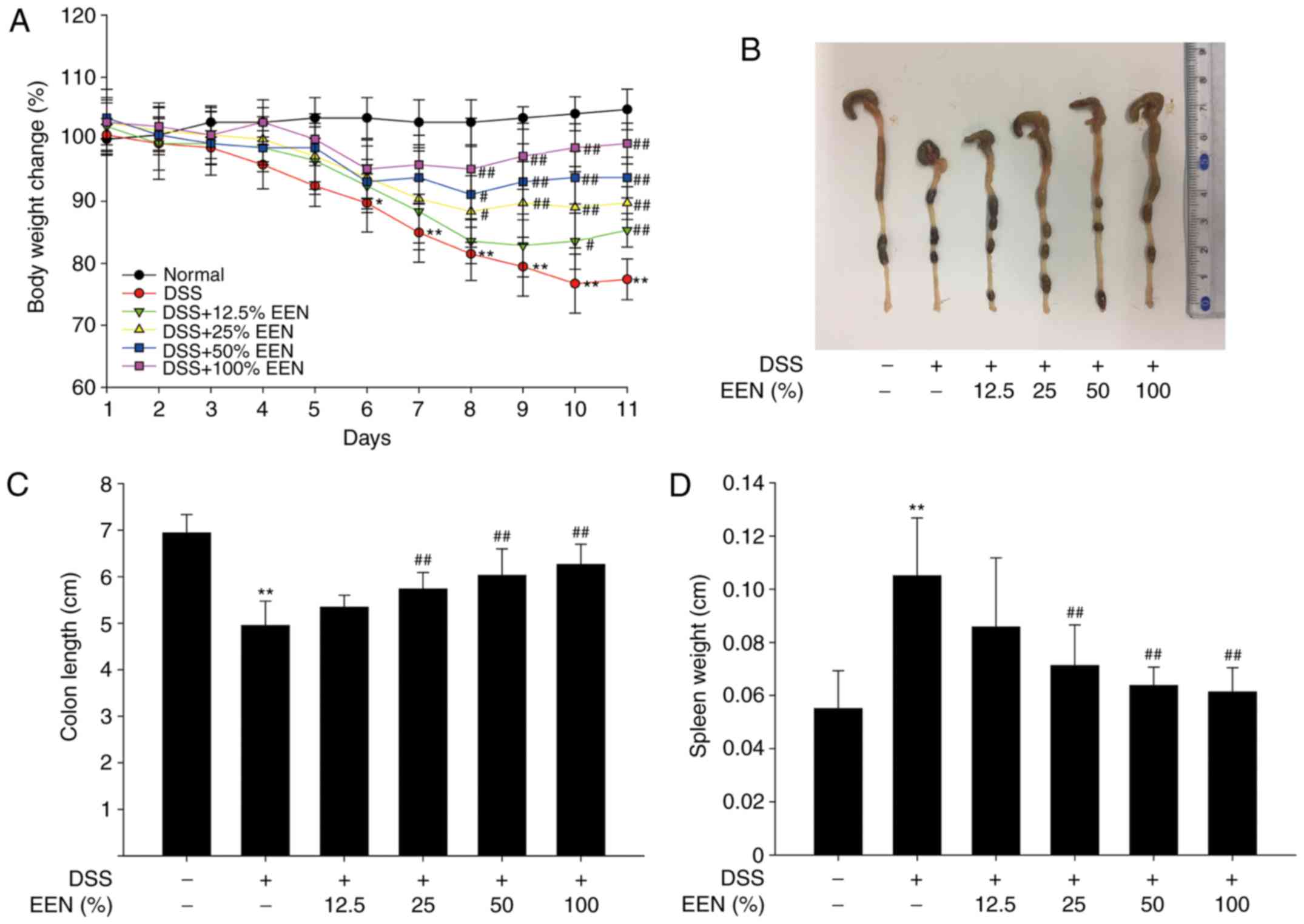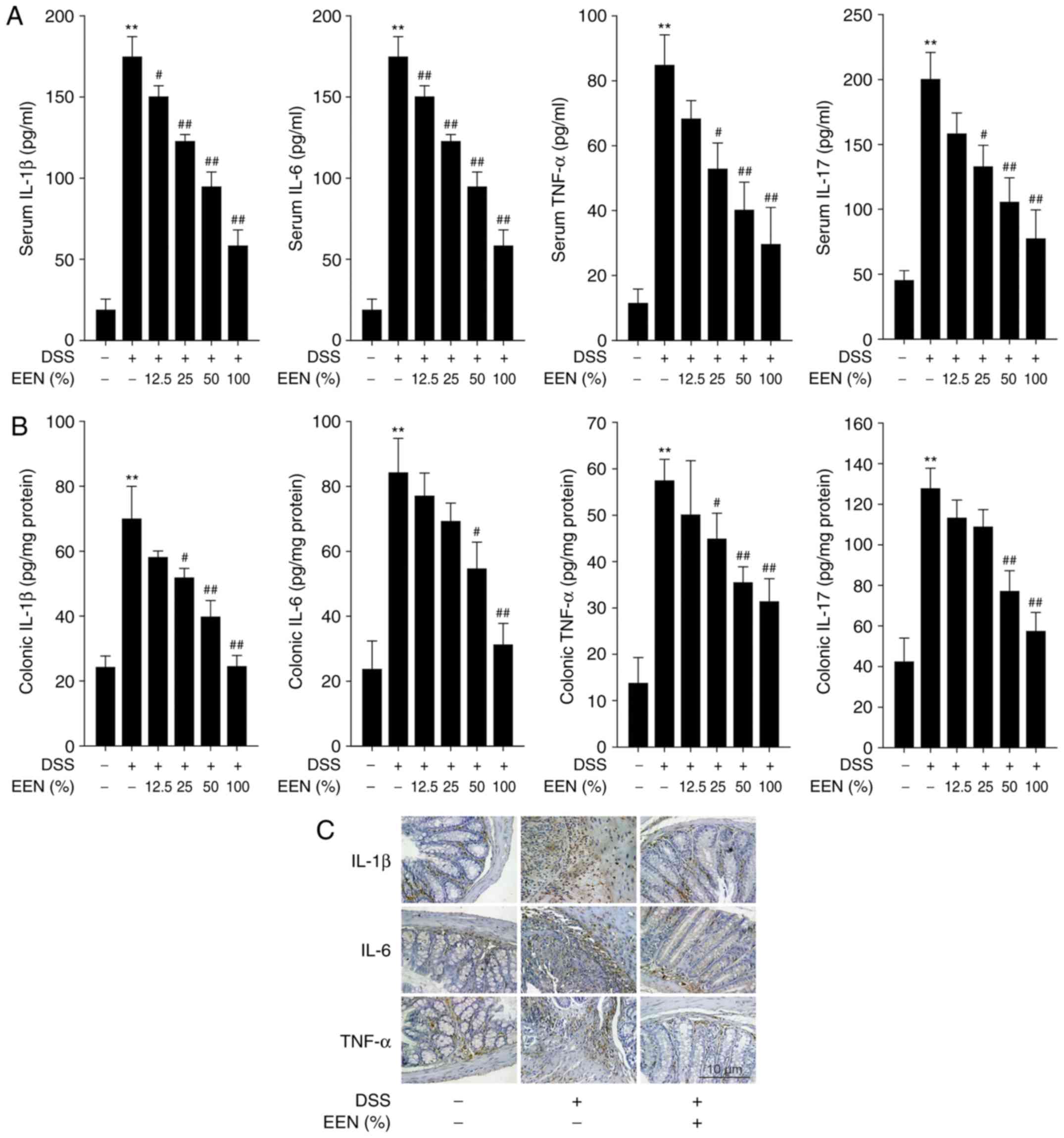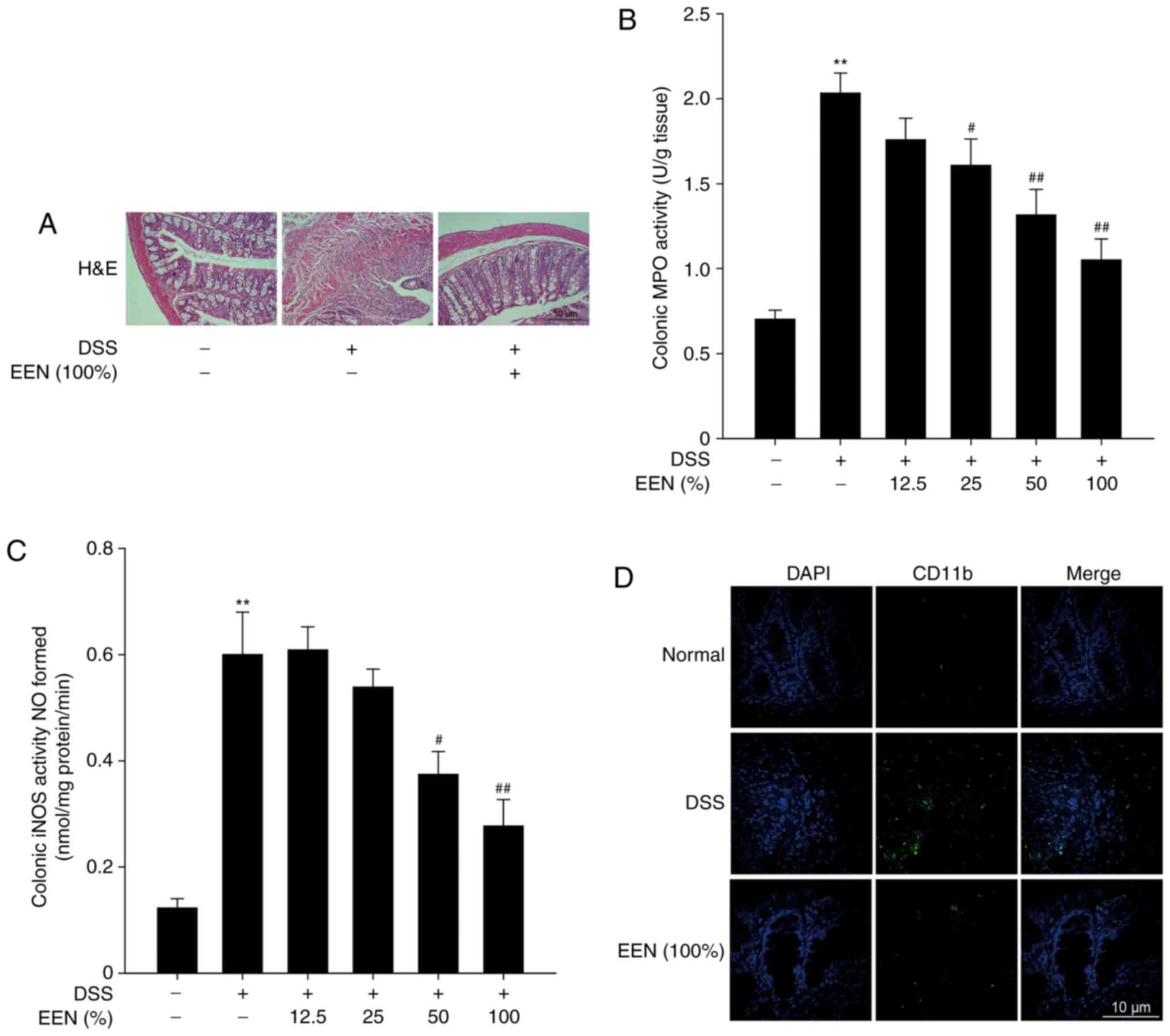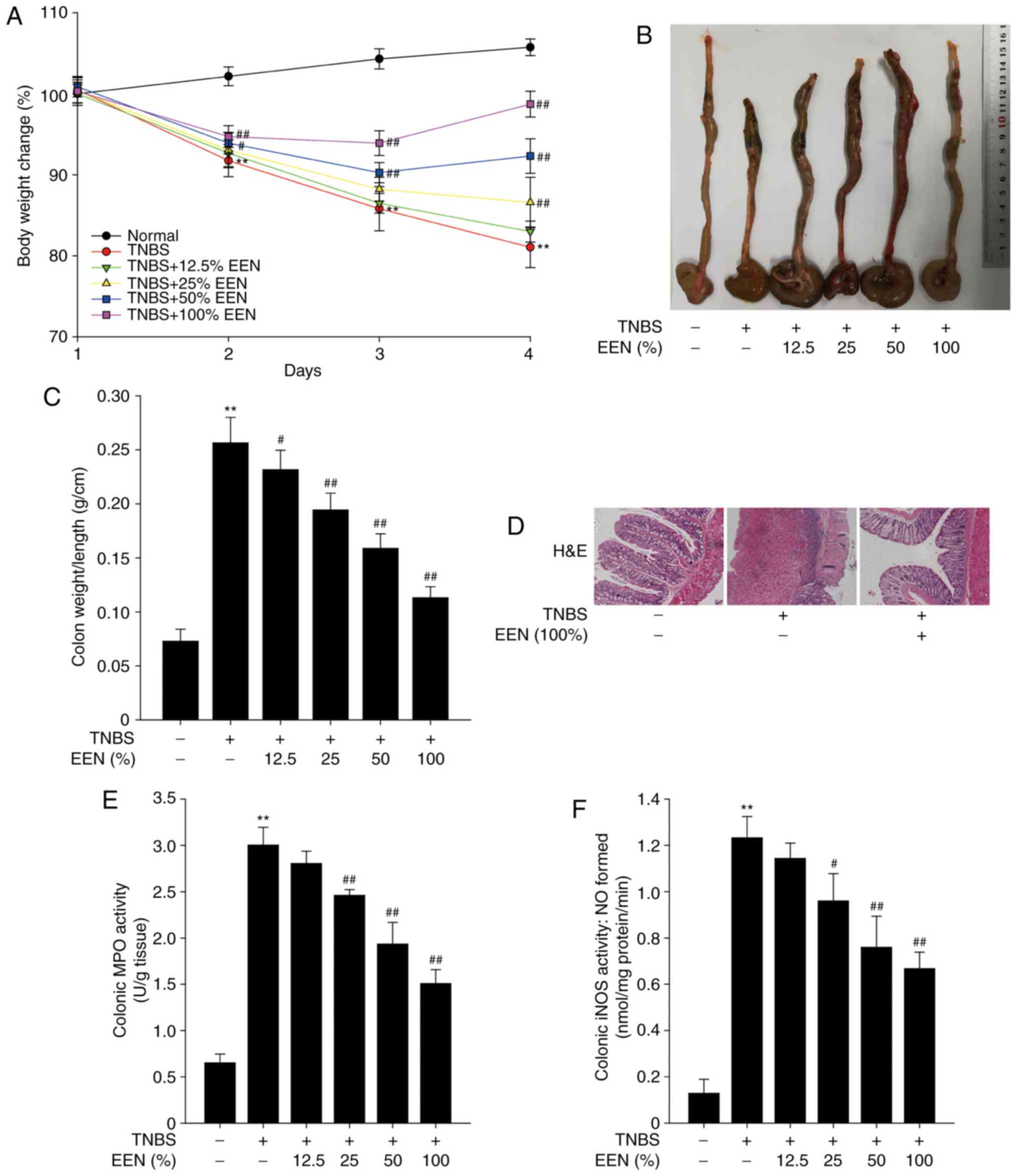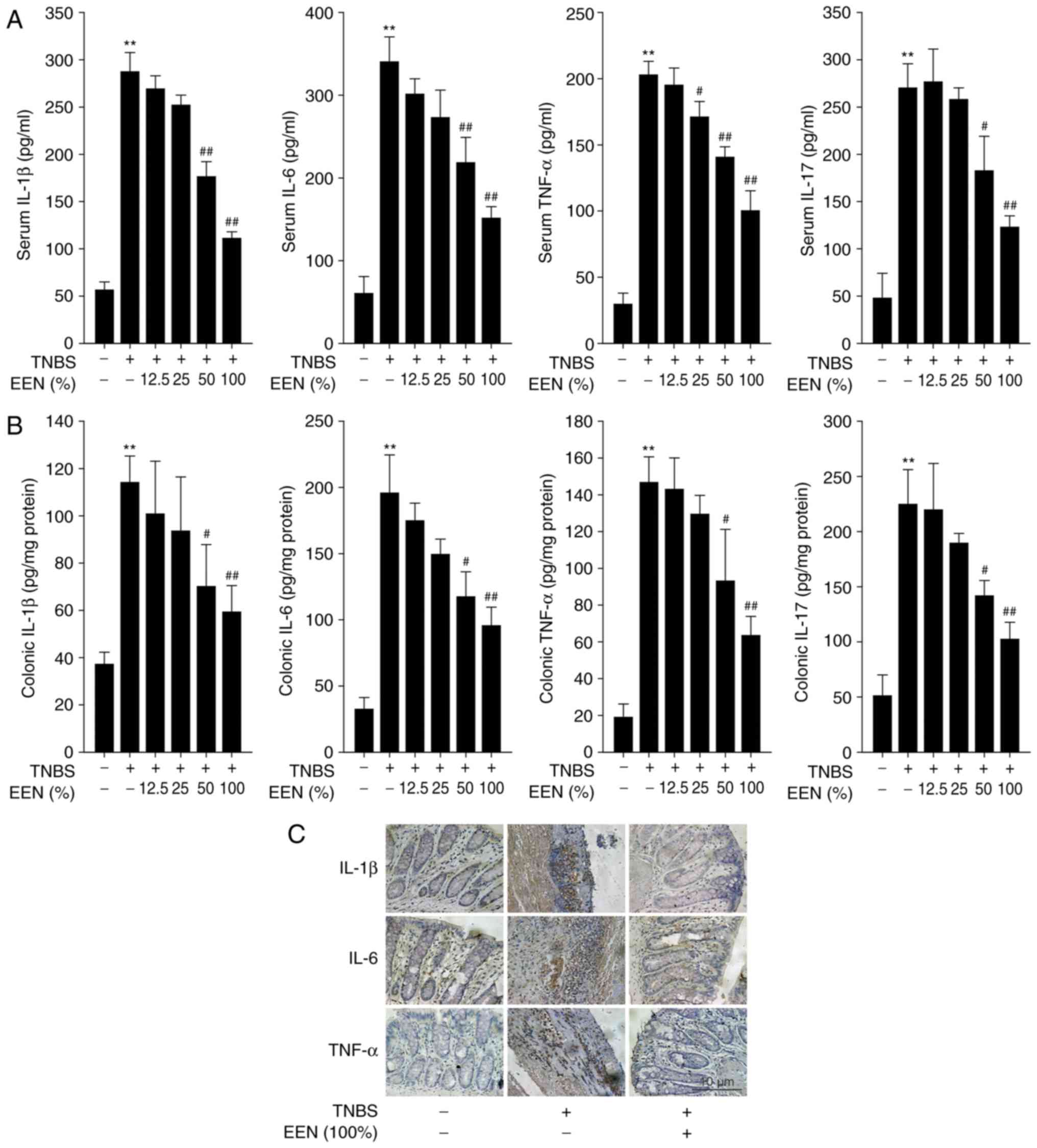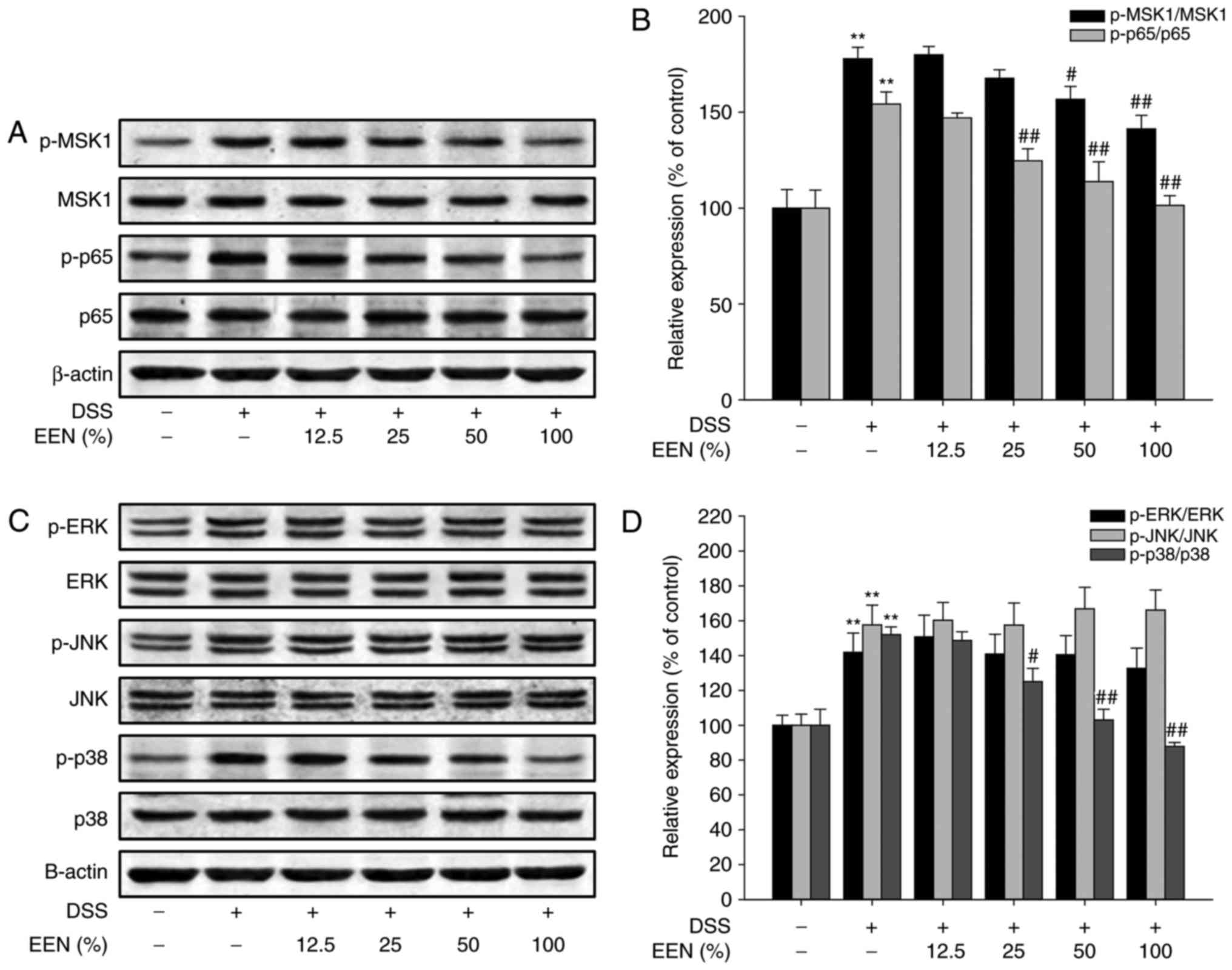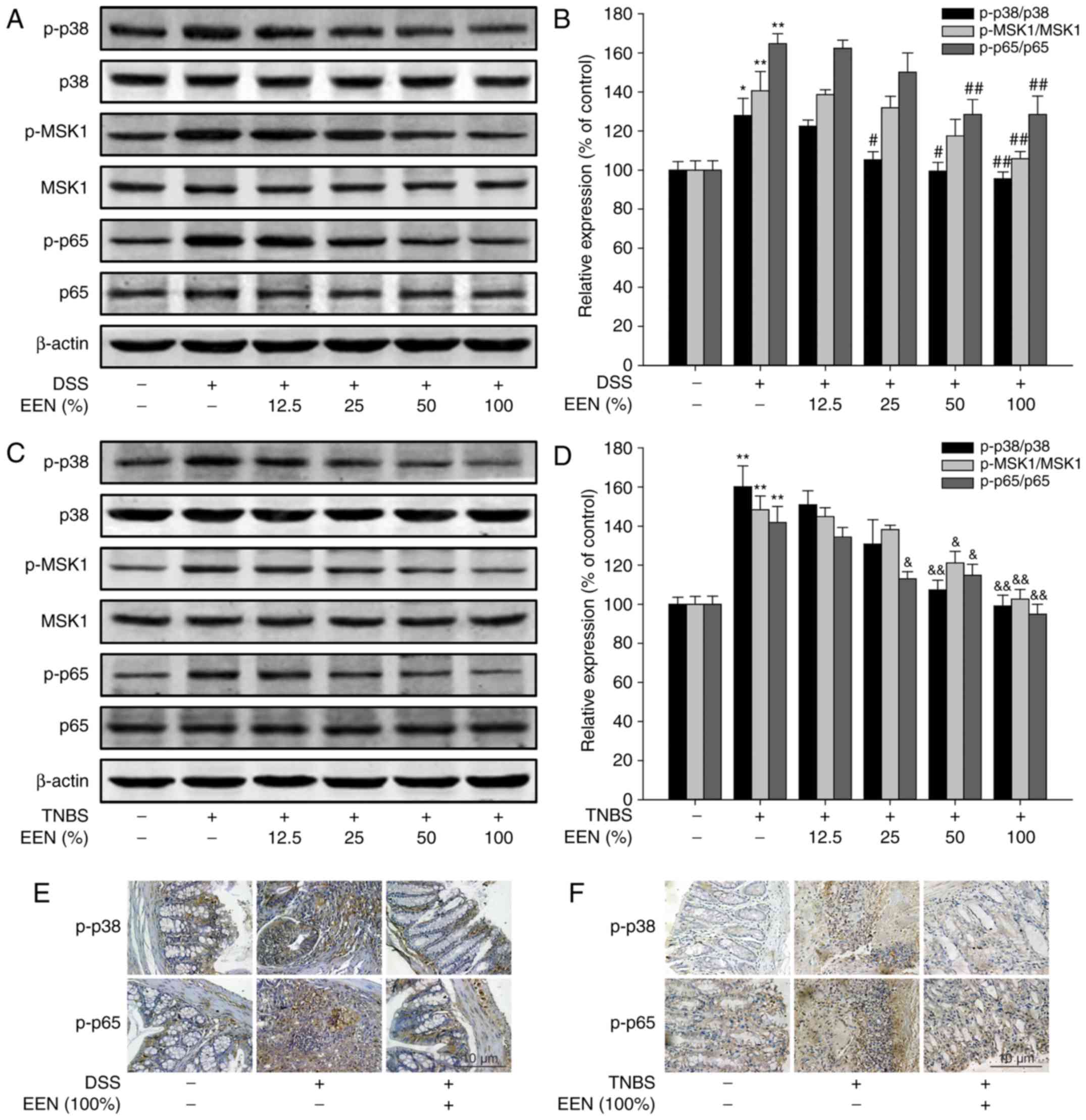Exclusive enteral nutrition protects against inflammatory bowel disease by inhibiting NF‑κB activation through regulation of the p38/MSK1 pathway
- Authors:
- Published online on: June 4, 2018 https://doi.org/10.3892/ijmm.2018.3713
- Pages: 1305-1316
-
Copyright: © Yu et al. This is an open access article distributed under the terms of Creative Commons Attribution License.
Abstract
Introduction
Ulcerative colitis (UC) is a multifactorial chronic inflammatory bowel disease (1,2). Although the pathophysiology of UC remains to be elucidated, experimental and clinical evidence suggests that chronic intestinal inflammation may be caused by dysfunction of the immune system (3). Excessive activation of the immune system results in persistent overproduction of inflammatory mediators, further recruitment and activation of immune cells, which exacerbates inflammatory responses (4). Therefore, regulating the secretion of inflammatory cytokines is vital to the improvement of intestinal inflammation.
During the pathogenesis of UC, a variety of inflammatory cytokines and chemokines are released and activate associated signaling pathways, such as tumor necrosis factor-α (TNF-α), interleukin (IL)-1β, IL-6 and IL-17, which activate inflammatory responses (5). The production of inflammatory mediators is regulated by a variety of transcription factors. Among these transcription factors, nuclear factor (NF)-κB serves a crucial role in regulating gene expression that encode cytokines, chemokines and other mediators associated with inflammatory responses (6–8).
The transcriptional activity of the transcription factor NF-κB can be regulated at multiple levels: The transcriptional activity of NF-κB is activated by degradation of IκBs, whereas the nuclear transcription potential of p65 is further regulated by post-translational modifications, such as phosphorylation, ubiquitination or acetylation (9). Notable, phosphorylation of p65 at Ser276, Ser529, and or Ser536 is essential for the promotion of gene expression (10). It has been demonstrated that phosphorylation of Ser276 is critical for transactivation of p65 (11). Phosphorylation at Ser276 p65 promotes the formation of stable complexes with coactivator CBP/p300 to enhance promoter function (10,12,13). Previous reports have demonstrated that mitogen- and stress-activated protein kinase-1 (MSK1), as a nuclear kinase, phosphorylated p65 at Ser276 and then promoted transcription of NF-κB target genes (10,14). Furthermore, the activity of MSK1 is regulated by p38 and extracellular signal-regulated kinase (ERK); MSK1 is directly activated by mitogen-activated protein kinase (MAPK) and stress-activated protein kinase/p38, and may mediate activation of cAMP response element-binding protein (15). In addition, the regulation of inducible nitric oxide synthase (iNOS) expression is also associated with NF-κB, which may be activated by complex kinase pathways including MSK1 (16,17).
UC can cause the body decreased food intake and nutrient absorption, and accelerated nutrient loss, which may result in malnutrition (18). It has previously been demonstrated that enteral nutrition can not only improve nutritional status, but also promotes mucosal remodeling and regulation of immune function (19). At present, various enteral nutrition formulae have been used in the treatment of inflammatory bowel disease (IBD), and the protective mechanism of intestinal mucosa has been previously studied (20,21). In the present study, the effects of exclusive enteral nutrition (EEN) on UC were examined and its possible mechanism was explored.
Materials and methods
Reagents and antibodies
Dextran sulfate sodium (DSS; molecular weight 36–50 kDa) was obtained from MP Biomedicals, LLC (Santa Ana, CA, USA). Picrylsulfonic acid solution (TNBS) was obtained from Sigma-Aldrich; Merck KGaA (Darmstadt, Germany). DAPI was purchased from Invitrogen; Thermo Fisher Scientific, Inc. (Waltham, MA, USA). Paraformaldehyde was purchased from Yonghua Chemical Technology (Jiangsu) Co., Ltd. (Changshu, China). Triton X-100 was purchased from Beyotime Institute of Biotechnology (Haimen, China). Bovine serum albumin (BSA) was purchased from Roche Diagnostics (Basel, Switzerland). Radioimmunoprecipitation assay lysis buffer was purchased from Beyotime Institute of Biotechnology.
Myeloperoxidase (MPO) activity assay kit was purchased from Nanjing Jiancheng Bioengineering Institute (Nanjing, China). iNOS assay kit was purchased from Beyotime Institute of Biotechnology. ELISA kits for mouse IL-1β (EK0394), IL-6 (EK0411), TNF-α (EK0527) and IL-17 (EK0431) were purchased from Boster Biological Technology (Pleasanton, CA, USA).
Primary antibodies against phosphorylated (p)-p65 (Ser276; sc-101749; 1:1,000), p65 (sc-109, 1:2,000), p-ERK1/2 (Thr177/Thr160; sc-23759-R; 1:1,000), p-c-Jun N-terminal kinase (JNK; G-7; sc-6254; 1:1,000), JNK (sc-7345; 1:2,000), p-p38 (Thr180; sc-101758; 1:1,000), p38 (sc-81621; 1:2,000) and β-actin (sc-47778; 1:2,000) were obtained from Santa Cruz Biotechnology, Inc. (Dallas, TX, USA), and antibodies against ERK1/2 (9102s; 1:2,000), p-MSK1 (Thr581; 9595; 1:1,000) and MSK1 (3489; 1:2,000) were purchased from Cell Signaling Technology, Inc. (Danvers, MA, USA). IRDye 800-conjugated secondary antibodies (anti-mouse, 072-07-18-06, 1:2,000; anti-rabbit, 072-07-15-06, 1:2,000) were obtained from Rockland Immunochemicals, Inc. (Pottstown, PA, USA). Fluorescein isothiocyanate (FITC)-anti-cluster of differentiation (CD)11b antibodies (11-0113-42) were purchased from eBioscience; Thermo Fisher Scientific, Inc. EEN was composed of 92% Ensure, which was purchased from Abbott Pharmaceutical Co. Ltd. (Lake Bluff, IL, USA); 6% dietary fiber, which was obtained from Hebei Vilof Agritech Co., Ltd. (Beijing, China); and 2% cod liver oil, which was obtained from Blackmores (Warriewood, Australia).
Animals
A total of 48 female 6–8 week old C57BL/6 mice, weighing 18–22 g, and 56 female 6–8 week old Sprague-Dawley rats, weighing 230–240 g, were supplied by Shanghai Laboratory Animal Center, China Academy of Sciences (Shanghai, China). Experimental protocols were performed in accordance with National Institutes of Health regulations and approved by the Institutional Animal Care and Use Committee (Shanghai Institute of Biochemistry and Cell Biology, Chinese Academy of Sciences, Shanghai, China). Throughout the acclimatization and study periods, all animals had access to food and water ad libitum and were maintained on in 12-h light/dark cycle at 21±2°C with a relative humidity of 45±10%.
DSS colitis
Colitis was induced by administration of DSS in drinking water. Mice were randomly assigned to normal, DSS-treated and EEN (12.5, 25, 50 or 100%)-treated groups (n=8/group; Table I). Mice received either drinking regular water (control) or 3% (w/v) DSS drinking water (model) for 7 days, and thereafter were provided regular water for 3 days. EEN was administered intragastrically from day 1–10 (22).
TNBS colitis
Following fasting for 8–12 h, rats were anesthetized with sodium pentobarbital (50 mg/kg, intraperitoneal; Beijing Ouhe Technology Co., Ltd., Beijing, China), and then a flexible catheter was inserted into the colon (3.5 cm proximal to the anus). To induce colitis, TNBS (2 mg in 100 µl 40% ethanol solution) was slowly administered. To assure the distribution of TNBS within the entire colon, rats were held upside down in a vertical position for 1 min and returned to their cages. The control group, received 100 µl 40% ethanol alone through the same technique. Rats were then given ad libitum access to food and water. EEN (12.5, 25, 50 or 100%) groups were treated via gavage (n=8/group; Table I) (22). Body weight changes were recorded once daily.
Macroscopic assessment and histological analysis of colonic lesions
Following DSS- and TNBS-induced colitis, animals were sacrificed, colons were removed, opened longitudinally and washed with PBS. The colon weights and lengths were measured and the ratio of weight:length was calculated for each group. Colonic tissue samples were fixed in 10% neutral-buffered formalin at room temperature for 24 h, and routinely embedded in paraffin and processed. Hematoxylin and eosin (H&E) staining was performed to clarify whether there was a difference in erosion of the lamina propria mucosa, disappearance of glandular epithelium and increased inflammatory cell infiltration compared among groups. The experiment was performed as follows: i) Samples were dewaxed and rehydrated in a descending alcohol series and washed in PBS; ii) hematoxylin staining at room temperature for 10 min; iii) washed with PBS for ~10 min; iv) washed with distilled water; v) 95% ethanol dehydration for 5 sec; vi) eosin staining at room temperature for 30 sec; vii) 95% ethanol dehydration for 2 min; viii) repeat step vii; ix) xylene soak at room temperature for 5 min x) repeat step ix; xi) slides were mounted and evaluated (original magnification, ×400) with fluorescent microscopy. Histological analysis was performed as previously described (23).
Immunofluorescence and immunohistochemistry of colon tissues
CD11b-positive cell infiltration analysis was performed on paraffin-embedded colon tissue sections. Briefly, the sections were deparaffinized at 60°C for 40 min, placed in xylene for dewaxing for 10 min, rehydrated in a descending alcohol series and washed in PBS. Following treatment with 3% hydrogen peroxide, blocking with 3% bovine serum albumin (BSA) at room temperature for 20 min, the sections were incubated for 1 h at room temperature with FITC-anti-CD11b antibodies (1:100). The slides were then counter-stained with DAPI for 30 min at room temperature. The reaction was stopped by thorough washing in water for 5 min. Images (original magnification, ×400) were acquired by confocal laser-scanning microscope (Olympus Corporation, Tokyo, Japan). Settings for image acquisition were identical for control and experimental tissues.
The expressions of IL-1β, IL-6, TNF-α, p-p38 (Thr180) and p-p65 (Ser276) of the colonic tissues was assessed as described in a previous study (24).
MPO activity and iNOS activity in colon tissue of rat colitis model
The colon tissues of rats were collected, accurately weighed, cut with ophthalmic scissors, homogenized using a homogenizer, transferred to an EP tube and centrifuged at 600 × g at 4°C for 5 min, and the cells were collected and tested for MPO activity and iNOS activity. MPO activity and iNOS activity kits were used according to the manufacturers’ protocols.
Cytokine quantification by enzyme-linked immunoassay
Colons from mice in each group were homogenated with radioimmunoprecipitation assay lysis buffer to extract total protein. The homogenate was centrifuged at 12,000 × g at 4°C for 15 min. The amount of total extracted protein was determined using a bicinchoninic acid protein assay kit (Thermo Fisher Scientific, Inc.). Following blood collection, static agglutination at room temperature for 2 h, samples were centrifuged at 900 × g for 10 min, and the upper serum was stored at −80°C. The amounts of IL-1β, IL-6, TNF-α and IL-17 in serum and colon homogenate were measured with ELISA kits according to the manufacturers’ protocols.
Isolation of peritoneal macrophages
Peritoneal macrophages were obtained from the peritoneal cavity of mice by injection of PBS. Cells were washed twice in PBS and suspended in RPMI-1640 medium (Gibco; Thermo Fisher Scientific, Inc.) containing 10% FBS, 10,000 U/ml penicillin and 10 mg/ml streptomycin. The macrophages suspended in culture medium were cultured in 24-well microplates for 40 min at 37°C in a moist atmosphere of 5% CO2. Non-adherent cells were removed by washing the plate twice with PBS. The adherent macrophages were used for western blot analysis.
Western blot analysis
After whole cell lysates were prepared. Western blot analysis was prepared as described previously (23). Protein samples (40 µg) were separated by 10% SDS-PAGE and transferred onto nitrocellulose membranes. The membranes were blocked with 1% BSA at 37°C for 1 h and incubated with primary antibodies overnight at 4°C, followed by IRDye800-conjugated secondary antibody for 1 h at 37°C. Immunoreactive protein was detected with an Odyssey Scanning System (Odyssey Application Software version 3.0.30; LI-COR Biosciences, Lincoln, NE, USA).
Statistical analysis
Data were obtained from at least three independent experiments and are presented as the mean ± standard deviation. Differences between the groups were assessed by one-way analysis of variance and Dunnett’s post hoc test. P<0.05 was considered to indicate a statistically significant difference.
Results
EEN attenuates DSS-induced colitis symptoms
In the present study, DSS-induced colitis was used in mice, a well-established preclinical model, exhibiting many phenotypic features of relevance to human UC (25). In general, DSS-induced colitis is characterized by a marked body weight loss. The present results demonstrated that DSS-treated mice exhibited marked body weight loss, whereas EEN groups were significantly different from the DSS model group (Fig. 1A). DSS-induced colitis causes colonic shortening in mice (26). Compared with DSS-treated mice, colonic shortening was significantly attenuated in EEN-treated mice (Fig. 1B and C). In addition, EEN ameliorated DSS-induced gain of spleen weight (Fig. 1D). These results suggested that EEN successfully attenuated DSS-induced colon inflammatory symptoms.
EERN decreases pro-inflammatory cytokines production in the serum and colon of DSS-induced mice
In general, DSS-induced colitis is characterized by high levels of cytokine production (27). To assess the effect of EEN on the inflammatory status of DSS-induced colitis, the levels of pro-inflammatory cytokines were examined. The expression of IL-1β, IL-6, TNF-α and IL-17 was increased significantly in the serum of DSS-induced colitis mice, compared with controls. However, EEN significantly inhibited the elevated levels of these cytokines (Fig. 2A). In addition, the expression of IL-1β, IL-6, TNF-α and IL-17 was also measured in colon homogenates. EEN significantly inhibited the expression of IL-1β, IL-6, TNF-α and IL-17 in DSS-induced colitis mice (Fig. 2B). Furthermore, EEN ameliorated the increased number of IL-1β-, IL-6- and TNF-α-positive cells in colonic mucosa of DSS-induced mice (Fig. 2C). These results suggested that EEN inhibited pro-inflammatory cytokines production in the serum and colon of DSS-induced mice.
EEN-attenuates colon injury in DSS-induced colitis mice
Subsequently, a pathological analysis of the colon tissue was performed to assess the effect of EEN on colon injury. H&E staining demonstrated that DSS group exhibited marked erosion of the lamina propria mucosa, disappearance of glandular epithelium and increased inflammatory cell infiltration compared with the normal group. Notably, EEN inhibited the infiltration of inflammatory cells and preserved intact colonic structure, with no marked ulceration (Fig. 3A). In addition, EEN significantly inhibited MPO and iNOS activities in DSS-induced mice (Fig. 3B and C). It has previously been demonstrated that CD11b is the surface antigen of many leukocytes, including monocytes, neutrophils, natural killer cells, granulocytes and macrophages (28). The accumulation of large amounts of CD11b-positive inflammatory cells was observed in the lesion site of colonic mucosa of DSS-induced mice. However, EEN reduced the number of infiltrating CD11b-positive inflammatory cells in colon tissues (Fig. 3D). These results suggested that EEN could successfully ameliorate colon injury in DSS-induced colitis.
EEN attenuates TNBS-induced colitis symptoms and colon injury
To further investigate the effect of EEN on colitis, colitis was induced in rat with TNBS. Similar to the DSS model, the TNBS-induced mice exhibited weight loss, and EEN groups were significantly different from the DSS model group (Fig. 4A). TNBS-induced rats exhibited shortening of the colon, whereas EEN ameliorated the shortening of the colon in TNBS-induced colitis rat (Fig. 4B). EEN also reduced colonic weight vs. length ratio in TNBS-induced colitis rats (Fig. 4C). The pathological analysis of colon tissue demonstrated that the mucosa layer was severely injured and a large number of inflammatory cells infiltrated in TNBS-induced colon tissue. However, EEN inhibited the infiltration of inflammatory cells and maintained the integrity of the colonic tissue structure (Fig. 4D). In addition, EEN significantly inhibited MPO an iNOS activities in TNBS-induced rats (Fig. 4E and F). These findings indicated that EEN ameliorated colitis symptoms and colon tissue injury in TNBS-induced colitis rat.
EEN decreases pro-inflammatory cytokine production in the serum and colon of TNBS-induced rats
As presented in Fig. 5A, the expression of IL-1β, IL-6, TNF-α and IL-17 was increased significantly in the serum of TNBS-induced colitis rats, whereas EEN significantly inhibited the elevated levels of these cytokines. In colon tissue homogenates, EEN also significantly reduced the production of IL-1β, IL-6, TNF-α and IL-17 in TNBS-induced colitis rats (Fig. 5B). Furthermore, EEN markedly decreased the number of IL-1β-, IL-6- and TNF-α-positive cells in colonic mucosa tissues of TNBS-induced rats (Fig. 5C). These data demonstrated that EEN suppressed pro-inflammatory cytokines production in the serum and colon of TNBS-induced rats.
EEN suppresses phosphorylation of p65 at Ser276 via inhibition of p38/MSK1 pathway in DSS-colitis mice and TNBS-colitis rat
The production of pro-inflammatory cytokines is regulated by a variety of transcription factors, in which NF-κB serves an important role in regulating inflammatory responses. To elucidate the anti-inflammation mechanism of EEN, the effect of EEN on the activation of p65 in peritoneal macrophages of DSS-colitis mice was examined. Notably, EEN downregulated p-p65 expression in peritoneal macrophages (Fig. 6A and B). Furthermore, detection of p-MSK1 expression, a kinase phosphorylated p65 at Ser276, revealed that EEN was able to downregulate phosphorylation of MSK1 (Fig. 6A and B). Previous studies have demonstrated that phosphorylation of MSK1 is regulated by the MAPK signaling pathway (29–31). Therefore, the effect of EEN on the MAPK signaling pathway was then examined. As presented in Fig. 6C and D, EEN downregulated phosphorylation of p38 without significantly affecting phosphorylation of ERK and JNK in peritoneal macrophages of DSS-colitis mice.
Then, the expression of related proteins was examined in colon tissue of DSS- and TNBS-induced colitis models. EEN downregulated phosphorylation of p38, MSK1 and p65 expression in colon tissue of DSS-induced colitis mice and TNBS-induced colitis rats (Fig. 7A–D). Immunohistochemical results demonstrated that EEN decreased the number of p-p38- and p-p65-positive cells in colonic tissues of DSS-induced colitis mice and TNBS-induced colitis rats (Fig. 7E and F). These findings suggest that EEN exerted the anti-inflammation effect by suppressing phosphorylation of p65 at Ser276 via inhibition of p38/MSK1 pathway in DSS-induced colitis mice and TNBS-induced colitis rat.
Discussion
UC is a prevalent inflammatory bowel disease in North America and Europe. The annual number of novel occurrences is 1–20 people per 100,000, with a total occurrence of 5–500 per 100,000 affected worldwide (32). At present, in developing countries, the incidence of UC is increasing (33,34). There are many clinical treatments for UC, including corticosteroids, sulfasalazine, classic immunosuppressive agents, and antibiotics. However, the majority of these drugs have limitations in wide clinical applications for their serious side effects (35,36). Therefore, there is an urgent need to develop novel drugs with minor side effects. The integrity of the epithelial structure is a key factor in preventing colon bacteria from migrating to the colon wall. Enteral nutrition from the circulating blood to colonic epithelial cell membrane is critical for structural integrity of the colonic epithelium, because nutrients serve an important role in the differentiation, proliferation and mucosal healing of colon epithelial cells (37).
Hundreds of millions of gut microbes parasites in the intestine (38). Under normal conditions, intestinal microorganisms and the host exist in a state of balance (39). Intestinal microorganisms activate the body’s immune response when the homeostasis of microorganisms and the host is destroyed, ultimately contributing to the development of IBD (40). Dietary fiber in EEN can be used by gut microbes to produce short-chain fatty acids that enhance the intestinal barrier and thus reduce the damage done to the body by the inflammatory response (41). In the present study, the effect of EEN on the body itself was evaluated.
The DSS-induced colitis model mimics human inflammatory bowel disease appropriately (42); therefore, this model was used to investigate the effect of EEN on colitis. In the present study, EEN attenuated colitis injury and inflammatory symptoms induced by DSS, such as weight loss, shortening of colon length and colonic tissue damage. In addition, EEN reduced MPO activity, an index of inflammation damage, which was a marker of neutrophil infiltration (43). The release of NO was modulated by iNOS activity, which damaged the intestinal mucosa and submucosa cells (44). The present study demonstrated that EEN also reduced iNOS activity in colonic tissue. Furthermore, EEN inhibits infiltration of inflammatory cells by decreasing CD11b-positive cell count. More importantly, EEN reduced the production of pro-inflammatory cytokines in serum and colon tissue, including IL-1β, IL-6, TNF-α and IL-17 (45). Comprehensive results demonstrated that EEN can alleviate DSS-induced colitis in mice. The DSS-induced colitis mouse model was established by letting mice freely drink water containing dissolved DSS. Therefore, the change of water intake in mice directly affected the level of DSS-induced colitis. In order to evaluate the protective effect of EEN on colitis in a comprehensive and systematic way, the effect of EEN on TNBS-induced colitis was also examined. In TNBS-induced colitis rats, EEN alleviated colitis injury and inflammatory symptoms and inhibited production of pro-inflammatory cytokines. To further investigate the mechanism of EEN, the activity of NF-κB was examined in peritoneal macrophages of DSS mice. Western blotting results demonstrated that EEN downregulated expression of p-p65 at Ser276. Further experiments demonstrated that EEN suppressed phosphorylation of p65 at Ser276 via inhibition of the p38/MSK1 pathway. Furthermore, this result was verified in colonic tissue of DSS- and TNBS-induced colitis models. In conclusion, EEN alleviated colitis by preventing phosphorylation of p65 at Ser276 via inhibition of p38/MSK1 pathway.
Previously, great efforts have been made to understand how NF-κB is activated by a variety of inducers including bacteria, viruses and cytokines (46). The classic IKKβ-IκBα signaling pathway is associated with activation of NF-κB via p65 nuclear translocation-dependent mechanism (47). In addition, the activation of NF-κB can also be carried out by post-translational modifications via phosphorylation of p65 at Ser276, Ser529 or Ser536 (48). Among them, Ser276 phosphorylation of p65 is very important for the activation of NF-κB; whether inhibiting Ser276 phosphorylation of p65 formation, or mutation of Ser276 blocking the ability of p65 to transactivate target genes (49). In addition, Ser276 phosphorylation may inhibit p65 degradation mediated by ubiquitin ligase SOCS-1 (10). It has previously been demonstrated that protein kinase A (PKA) catalytic subunit is associated with Ser276 phosphorylation of p65 formation (10). Besides PKA, another report demonstrated that p65 was phosphorylated at Ser276 by MSK1 as a nuclear kinase (10). The present study demonstrated that phosphorylation of MSK1 expression was downregulated following EEN treatment. This suggests that EEN attenuated colitis by regulation of p65 activation via acting on MSK1. MSK1 is activated by the MAPK/ERK or SAPK2/p38 pathways (31). In the present study, it was demonstrated that p38 was inhibited but had no influence on ERK and JNK following EEN treatment. These data indicated that the p38/MSK1 pathway is associated with inhibition of p65 activation by EEN treatment.
These findings suggest that EEN alleviates DSS- and TNBS-induced colitis and illustrate its anti-inflammatory mechanism by inhibiting Ser276 phosphorylation of p65 via regulating p38/MSK1 pathway. Therefore, EEN may be an effective therapy for the treatment UC in humans. However, intestinal flora is complex. Inflammatory bowel disease is associated with other genetic, environmental, microbiological and immune factors. The exact etiology and pathogenesis are still unclear. Furthermore, the clinical value of EEN requires further investigation with a larger clinical sample size, collecting more data and conducting an in-depth study.
Acknowledgments
Not applicable.
Funding
The present study was supported by the National Natural Science Foundation of China (grant no. 81470819).
Availability of data and materials
The datasets used and/or analyzed during the present study are available from the corresponding author on reasonable request.
Authors’ contributions
TY and CY conceived the idea. TY and QY performed the literature search. TY wrote the manuscript. TY, QY performed the majority of the molecular biology experiments; TY, QY, XC performed the majority of the cellular experiments; TY, LZ, YW and CY performed the majority of the animal experiments. All authors read and approved the final manuscript.
Ethics approval and consent to participate
Experimental protocols were performed in accordance with National Institutes of Health regulations and approved by the Institutional Animal Care and Use Committee (Shanghai Institute of Biochemistry and Cell Biology, Chinese Academy of Sciences, Shanghai, China).
Patient consent for publication
Not applicable.
Competing interests
The authors declare that they have no competing interests.
References
|
D’Arcangelo G and Aloi M: Inflammatory bowel disease-unclassified in children: Diagnosis and pharmacological management. Paediatri Drugs. 19:113–120. 2017. View Article : Google Scholar | |
|
Mărginean CO, Meliţ LE, Mocanu S and Mărginean MO: Inflammatory bowel diseases: a burden in pediatrics: Case series and a review of the literature. Medicine. 96:e63292017. View Article : Google Scholar | |
|
Francescone R, Hou V and Grivennikov SI: Cytokines, IBD, and colitis-associated cancer. Inflamm Bowel Dis. 21:409–418. 2015. View Article : Google Scholar : PubMed/NCBI | |
|
Russo RA and Katsicas MM: Autoinflammatory diseases. Medicina (B Aires). 76:166–172. 2016.In Spanish. | |
|
Striz I, Brabcova E, Kolesar L and Sekerkova A: Cytokine networking of innate immunity cells: A potential target of therapy. Clin Sci (Lond). 126:593–612. 2014. View Article : Google Scholar | |
|
Estruch M, Sanchez-Quesada JL, Ordoñez-Llanos J and Benitez S: Inflammatory intracellular pathways activated by electronegative LDL in monocytes. Biochim Biophys Acta. 1861.963–969. 2016. | |
|
Patel SJ, Jindal R, King KR, Tilles AW and Yarmush ML: The inflammatory response to double stranded DNA in endothelial cells is mediated by NFκB and TNFα. PloS One. 6:e199102011. View Article : Google Scholar | |
|
Kweon SM, Wang B, Rixter D, Lim JH, Koga T, Ishinaga H, Chen LF, Jono H, Xu H and Li JD: Synergistic activation of NF-kappaB by nontypeable H. influenzae and S. pneumoniae is mediated by CK2, IKKbeta-IkappaBalpha, and p38 MAPK. Biochem Biophys Res Commun. 351:368–375. 2006. View Article : Google Scholar : PubMed/NCBI | |
|
Schmitz ML, Mattioli I, Buss H and Kracht M: NF-kappaB: A multifaceted transcription factor regulated at several levels. Chembiochem. 5:1348–1358. 2004. View Article : Google Scholar : PubMed/NCBI | |
|
Nihira K, Ando Y, Yamaguchi T, Kagami Y, Miki Y and Yoshida K: Pim-1 controls NF-kappaB signalling by stabilizing RelA/p65. Cell Death Differ. 17:689–698. 2010. View Article : Google Scholar | |
|
Arun P, Brown MS, Ehsanian R, Chen Z and Van Waes C: Nuclear NF-kappaB p65 phosphorylation at serine 276 by protein kinase A contributes to the malignant phenotype of head and neck cancer. Clin Cancer Res. 15:5974–5984. 2009. View Article : Google Scholar : PubMed/NCBI | |
|
Kawashima T, Murata K, Akira S, Tonozuka Y, Minoshima Y, Feng S, Kumagai H, Tsuruga H, Ikeda Y, Asano S, et al: STAT5 induces macrophage differentiation of M1 leukemia cells through activation of IL-6 production mediated by NF-kappaB p65. J Immunol. 167:3652–3660. 2001. View Article : Google Scholar : PubMed/NCBI | |
|
Shen YM, Zhao Y, Zeng Y, Yan L, Chen BL, Leng AM, Mu YB and Zhang GY: Inhibition of Pim-1 kinase ameliorates dextran sodium sulfate-induced colitis in mice. Dig Dis Sci. 57:1822–1831. 2012. View Article : Google Scholar : PubMed/NCBI | |
|
Zeng S, Zhang QY, Huang J, Vedantham S, Rosario R, Ananthakrishnan R, Yan SF, Ramasamy R, DeMatteo RP, Emond JC, et al: Opposing roles of RAGE and Myd88 signaling in extensive liver resection. FASEB J. 26:882–893. 2012. View Article : Google Scholar : | |
|
Zhang HM, Li L, Papadopoulou N, Hodgson G, Evans E, Galbraith M, Dear M, Vougier S, Saxton J and Shaw PE: Mitogen-induced recruitment of ERK and MSK to SRE promoter complexes by ternary complex factor Elk-1. Nucleic Acids Res. 36:2594–2607. 2008. View Article : Google Scholar : PubMed/NCBI | |
|
Basu S, Pathak S, Pathak SK, Bhattacharyya A, Banerjee A, Kundu M and Basu J: Mycobacterium avium-induced matrix metalloproteinase-9 expression occurs in a cyclooxygenase-2-dependent manner and involves phosphorylation- and acetylation-dependent chromatin modification. Cell Microbiol. 9:2804–2816. 2007. View Article : Google Scholar : PubMed/NCBI | |
|
Vermeulen L, De Wilde G, Van Damme P, Vanden Berghe W and Haegeman G: Transcriptional activation of the NF-kappaB p65 subunit by mitogen- and stress-activated protein kinase-1 (MSK1). EMBO J. 22:1313–1324. 2003. View Article : Google Scholar : PubMed/NCBI | |
|
Pan Y, Liu Y, Guo H, Jabir MS, Liu X, Cui W and Li D: Associations between folate and vitamin B12 levels and inflammatory bowel disease: A meta-analysis. Nutrients. 9:E3822017. View Article : Google Scholar : PubMed/NCBI | |
|
Wang F, Zhao HY, Zhang ST, Gong YZ, Zhang HF and Zhang C: Effect of enteral nutrition on dextran sulfate sodium-induced colitis in rats. J Dig Dis. 12:453–458. 2011. View Article : Google Scholar : PubMed/NCBI | |
|
Park MY, Kwon HJ and Sung MK: Dietary aloin, aloesin, or aloe-gel exerts anti-inflammatory activity in a rat colitis model. Life Sci. 88:486–492. 2011. View Article : Google Scholar : PubMed/NCBI | |
|
El-Jamal N, Erdual E, Neunlist M, Koriche D, Dubuquoy C, Maggiotto F, Chevalier J, Berrebi D, Dubuquoy L, Boulanger E, et al: Glugacon-like peptide-2: Broad receptor expression, limited therapeutic effect on intestinal inflammation and novel role in liver regeneration. Am J Physiol Gastrointest Liver Physiol. 307:G274–G285. 2014. View Article : Google Scholar : PubMed/NCBI | |
|
Alex P, Zachos NC, Nguyen T, Gonzales L, Chen TE, Conklin LS, Centola M and Li X: Distinct cytokine patterns identified from multiplex profiles of murine DSS and TNBS-induced colitis. Inflamm Bowel Dis. 15:341–352. 2009. View Article : Google Scholar : | |
|
Yao J, Pan D, Zhao Y, Zhao L, Sun J, Wang Y, You QD, Xi T, Guo QL and Lu N: Wogonin prevents lipopolysaccharide-induced acute lung injury and inflammation in mice via peroxisome proliferator-activated receptor gamma-mediated attenuation of the nuclear factor-kappaB pathway. Immunology. 143:241–257. 2014. View Article : Google Scholar : PubMed/NCBI | |
|
Zhao Y, Sun Y, Ding Y, Wang X, Zhou Y, Li W, Huang S, Li Z, Kong L, Guo Q and Lu N: GL-V9, a new synthetic flavonoid derivative, ameliorates DSS-induced colitis against oxidative stress by up-regulating Trx-1 expression via activation of AMPK/FOXO3a pathway. Oncotarget. 6:26291–26307. 2015. View Article : Google Scholar : PubMed/NCBI | |
|
Cabre E, Mañosa M, Garcia-Sanchez V, García-Sánchez V, Gutiérrez A, Ricart E, Esteve M, Guardiola J, Aguas M, Merino O, et al: Phenotypic concordance in familial inflammatory bowel disease (IBD). Results of a nationwide IBD Spanish database. J Crohns Colitis. 8:654–661. 2014. View Article : Google Scholar : PubMed/NCBI | |
|
Fukuda T, Majumder K, Zhang H, Turner PV, Matsui T and Mine Y: Adenine inhibits TNF-α signaling in intestinal epithelial cells and reduces mucosal inflammation in a dextran sodium sulfate-induced colitis mouse model. J Agric Food Chem. 64:4227–4234. 2016. View Article : Google Scholar : PubMed/NCBI | |
|
Morin C, Blier PU and Fortin S: MAG-EPA reduces severity of DSS-induced colitis in rats. Am J Physiol Gastrointest Liver Physiol. 310:G808–G821. 2016. View Article : Google Scholar : PubMed/NCBI | |
|
Shah KH, Shi P, Giani JF, Janjulia T, Bernstein EA, Li Y, Zhao T, Harrison DG, Bernstein KE and Shen XZ: Myeloid Suppressor cells accumulate and regulate blood pressure in hypertension. Circ Res. 117:858–869. 2015. View Article : Google Scholar : PubMed/NCBI | |
|
Reber L, Vermeulen L, Haegeman G and Frossard N: Ser276 phosphorylation of NF-κB p65 by MSK1 controls SCF expression in inflammation. PloS One. 4:e43932009. View Article : Google Scholar | |
|
Schiller M, Bohm M, Dennler S, Ehrchen JM and Mauviel A: Mitogen- and stress-activated protein kinase 1 is critical for interleukin-1-induced, CREB-mediated, c-fos gene expression in keratinocytes. Oncogene. 25:4449–4457. 2006. View Article : Google Scholar : PubMed/NCBI | |
|
Deak M, Clifton AD, Lucocq LM and Alessi DR: Mitogen- and stress-activated protein kinase-1 (MSK1) is directly activated by MAPK and SAPK2/p38, and may mediate activation of CREB. EMBO J. 17:4426–4441. 1998. View Article : Google Scholar : PubMed/NCBI | |
|
Burisch J: Crohn’s disease and ulcerative colitis. Occurrence, course and prognosis during the first year of disease in a European population-based inception cohort. Dan Med J. 61:B47782014. | |
|
McDermott F, Hughes ES and Pihl E: Mortality and morbidity of Crohn’s disease and ulcerative colitis in Australia. Med J Aust. 1:534–536. 1980.PubMed/NCBI | |
|
Grimm IS and Friedman LS: Inflammatory bowel disease in the elderly. Gastroenterol Clin North Am. 19:361–389. 1990.PubMed/NCBI | |
|
Reich K, Leonardi C, Langley RG, Warren RB, Bachelez H, Romiti R, Ohtsuki M, Xu W, Acharya N, Solotkin K, et al: Inflammatory bowel disease among patients with psoriasis treated with ixekizumab: A presentation of adjudicated data from an integrated database of 7 randomized controlled and uncontrolled trials. J Am Acad Dermatol. 76:441–448e2. 2017. View Article : Google Scholar | |
|
Archer R, Tappenden P, Ren S, Martyn-St James M, Harvey R, Basarir H, Stevens J, Carroll C, Cantrell A, Lobo A and Hoque S: Infliximab, adalimumab and golimumab for treating moderately to severely active ulcerative colitis after the failure of conventional therapy (including a review of TA140 and TA262): Clinical effectiveness systematic review and economic model. Health Technol Assess. 20:1–326. 2016. View Article : Google Scholar : PubMed/NCBI | |
|
Perdikis DA and Basson MD: Basal nutrition promotes human intestinal epithelial (Caco-2) proliferation, brush border enzyme activity, and motility. Crit Care Med. 25:159–165. 1997. View Article : Google Scholar : PubMed/NCBI | |
|
Zaiss MM, Rapin A, Lebon L, Dubey LK, Mosconi I, Sarter K, Piersigilli A, Menin L, Walker AW, Rougemont J, et al: The intestinal microbiota contributes to the ability of helminths to modulate allergic inflammation. Immunity. 43:998–1010. 2015. View Article : Google Scholar : PubMed/NCBI | |
|
Vitetta L, Saltzman ET, Nikov T, Ibrahim I and Hall S: Modulating the gut micro-environment in the treatment of intestinal parasites. J Clin Med. 5:E1022016. View Article : Google Scholar : PubMed/NCBI | |
|
No authors listed. Inflammatory bowel disease. Prog Drug Res. 71:117–122. 2016.PubMed/NCBI | |
|
Jandhyala SM, Talukdar R, Subramanyam C, Vuyyuru H, Sasikala M and Nageshwar Reddy D: Role of the normal gut microbiota. World J Gastroenterol. 21:8787–8803. 2015. View Article : Google Scholar : PubMed/NCBI | |
|
Dae Park D, Yum HW, Zhong X, Kim SH, Kim SH, Kim DH, Kim SJ, Na HK, Sato A, Miura T and Surh YJ: Perilla frutescens extracts protects against dextran sulfate sodium-induced murine colitis: NF-κB, STAT3, and Nrf2 as putative targets. Front Pharmacol. 8:4822017. View Article : Google Scholar | |
|
Kono H, Fujii H, Ogiku M, Tsuchiya M, Ishii K and Hara M: Enteral diets enriched with medium-chain triglycerides and N-3 fatty acids prevent chemically induced experimental colitis in rats. Transl Res. 156:282–291. 2010. View Article : Google Scholar : PubMed/NCBI | |
|
Kawahara R, Yasuda M, Hashimura H, Amagase K, Kato S and Takeuchi K: Activation of α7 nicotinic acetylcholine receptors ameliorates indomethacin-induced small intestinal ulceration in mice. Eur J Pharmacol. 650:411–417. 2011. View Article : Google Scholar | |
|
Hata K, Andoh A, Shimada M, Fujino S, Bamba S, Araki Y, Okuno T, Fujiyama Y and Bamba T: IL-17 stimulates inflammatory responses via NF-kappaB and MAP kinase pathways in human colonic myofibroblasts. Am J Physiol Gastrointest Liver Physiol. 282:G1035–G1044. 2002. View Article : Google Scholar : PubMed/NCBI | |
|
Rivera-Serrano EE and Sherry B: NF-κB activation is cell type-specific in the heart. Virology. 502:133–143. 2017. View Article : Google Scholar : PubMed/NCBI | |
|
Lim H, Lee H, Noh K and Lee SJ: IKK/NF-κB-dependent satellite glia activation induces spinal cord microglia activation and neuropathic pain after nerve injury. Pain. 158:1666–1677. 2017. View Article : Google Scholar : PubMed/NCBI | |
|
Durand JK and Baldwin AS: Targeting IKK and NF-κB for therapy. Adv Protein Chem Struct Biol. 107:77–115. 2017. View Article : Google Scholar | |
|
Rinkenbaugh AL, Cogswell PC, Calamini B, Dunn DE, Persson AI, Weiss WA, Lo DC and Baldwin AS: IKK/NF-κB signaling contributes to glioblastoma stem cell maintenance. Oncotarget. 7:69173–69187. 2016. View Article : Google Scholar : PubMed/NCBI |



